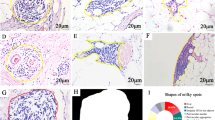Abstract
The role that milky spots in the greater omentum play in tumour cell spread in the peritoneal cavity is presently not fully understood. To study whether intraperitoneally injected tumour cells appear preferentially in milky spots of the greater omentum and to study the changes in the greater omentum, and especially in the cell population of milky spots after tumour cell infiltration, the following study was performed. A detailed temporal sequences of changes in morphology and cellular composition in milky spots of the greater omentum of Wag/Rij rats 5, 15, 30, 60 min, 2, 4, 8, 16, 24 h, 2, 4, 8 days and 2 and 4 weeks after intraperitoneal administration of 2.0 × 106 CC 531 tumour cells was investigated by light microscopy and electron microscopy (pre-embedding labelling). Our data showed that the milky spots in the greater omentum were the sites to which tumour cells migrated preferentially from the peritoneal cavity. The tumour cells infiltrated the milky spots and formed clusters within. The cellular population in milky spots reacted by a very rapid influx of young macrophages during the first hour and an increase of the total number of cells (P < 0.01). After 4 h tumour cells were also located on the greater omentum outside the area of the milky spots. Around these tumour cell deposits, new milky spots are formed, which increased the total number of milky spots. The cells present in milky spots are not capable of reversing the growth of tumours and finally a solid omental cake of tumour cells is formed.
Similar content being viewed by others
Author information
Authors and Affiliations
Additional information
Received: 30 June 1998 / Accepted: 3 September 1998
Rights and permissions
About this article
Cite this article
Krist, L., Kerremans, M., Broekhuis-Fluitsma, D. et al. Milky spots in the greater omentum are predominant sites of local tumour cell proliferation and accumulation in the peritoneal cavity. Cancer Immunol Immunother 47, 205–212 (1998). https://doi.org/10.1007/s002620050522
Issue Date:
DOI: https://doi.org/10.1007/s002620050522




